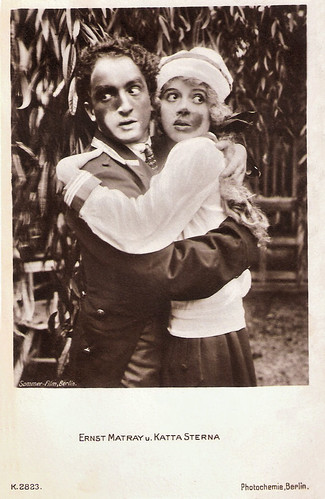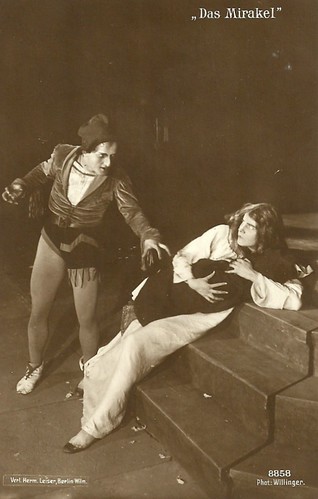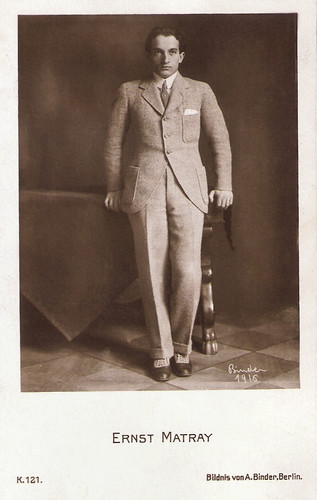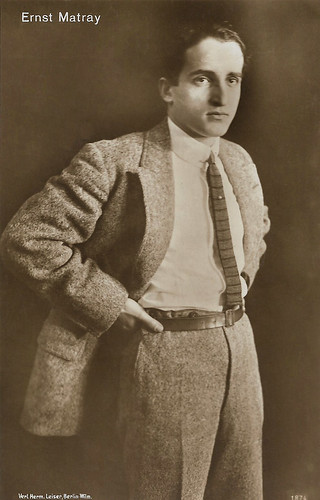Ernst Matráy (1891-1978) was a Hungarian dancer, choreographer, actor and film director. In Berlin, he worked with Max Reinhardt and Ernst Lubitsch. Together with his wife Maria Solveg, he later did the choreography for some classic Hollywood films.

German postcard by Photochemie, Berlin, no. K.2823. Photo: Sommer Film, Berlin. Ernst Matray with Katta Sterna.

German postcard by Rotophot in the Film Sterne series, no. 516/4, 1919-1924. Photo: May-Film. Mia May and Ernst Matray in Hilde Warren und der Tod (Joe May, 1917).
Ernst Matráy (or Matray) was born as Erno Siblatt in Budapest, Austria-Hungary, in 1891. As a boy, he had ballet lessons. In 1907, he was spotted as a dancer by the famous German stage director Max Reinhardt. Reinhardt engaged him for the Deutsche Theatre in Berlin. Matráy worked there as an actor, dancer, choreographer and mime. He drew attention to himself in quirky roles that were specially written for him. In 'Sumurun' (1908) he played a hunchback and in 'Das Mirakel' (The Miracle, 1911) a minstrel.
Matráy also appeared in film adaptations of Reinhardt productions such as Das Mirakel / The Miracle (Michel Carré, 1912), Die Insel der Seligen / The Isle of the Blessed (Max Reinhardt, 1913) and Eine venezianische Nacht / A Venetian Night (Max Reinhardt, 1913), so he was experienced with working for the camera early on.
Before and during the First World War, he was repeatedly seen as grotesque dancers in film comedies like Tangofieber / Tango Fever (Carl Wilhelm, 1913) with Albert Paulig, and Marionetten / Marionettes (Richard Löwenbein, 1915) with Katta Sterna. Matráy and Sterna often played together, and they were an ideal film couple.
Matráy also directed several films, including Das Phantom der Oper / The Phantom of the Opera (Ernst Matráy, 1915) with Nils Chrisander, and Teufelchen / Little Devil (Ernst Matráy, 1915). In 1915, he founded Malu-film together with Ernst Lubitsch and produced Zucker und Zimt / Sugar and cinnamon (Ernst Lubitsch, 1915).
Matráy also worked as a screenwriter together with his first wife, Greta Schröder. He appeared in films like Hilde Warren und der Tod / Hilde Warren and Death (Joe May, 1917), based on a script by Fritz Lang, and Nathan der Weise / Nathan the Wise (Manfred Noa, 1922) with Werner Krauss. In 1922, he took over the artistic direction of the International Pantomime Company. With his ensemble, he went on tour internationally.

German postcard by Verlag Hermann Leiser, Berlin, no. 8858. Photo: Willinger. The photo was made for either the stage play 'Das Mirakel' (The Miracle, 1911) or the Austrian-British film Das Mirakel / The Miracle (1912). The card shows Ernst Matráy as the Evil Genius and, in the film, Florence Winston as Megildis, the nun who has escaped the convent and now has a baby. The Miracle was released in Germany in August 1914 and premiered at the Circus Busch. It had its world premiere in Covent Garden, London, in 1912.
In 1924 Ernst Matráy divorced Greta Schröder and in 1927 he married the actress Maria Solveg, who was the sister of his dance partner Katta Sterna. With his second wife, he worked for years on the development of ballet choreography.
After a last appearance of the Matray Ballet at the end of 1933 in the Ufa-Palast am Zoo, Matráy and Solveg emigrated via England to the United States. There the couple worked as choreographers for Revue troops. In order to get by financially the couple also sold apartments along the way.
Thanks to the German immigrant directors William Dieterle and Reinhold Schünzel, they could work on the choreography of some Hollywood films. These included The Hunchback of Notre Dame (William Dieterle, 1939) with Charles Laughton, Pride and Prejudice (Robert Z. Leonard, 1940) with Greer Garson, A Woman's Face (George Cukor, 1941), and Random Harvest (Mervyn LeRoy, 1942) with Ronald Colman. Matráy was the co-director of the small compilation film Adventure in Music (Reginald LeBorg, S. K. Winston, Ernst Matray, 1944). Till 1945, he worked on 23 Hollywood films, often for MGM.
In 1953 the Matrays moved to Zurich in Switzerland. Matray staged at the Deutsches Schauspielhaus in Hamburg Molière's 'George Dandin' and Jacques Offenbach's 'La vie parisienne' (Parisian life). At the same time he worked as a choreographer for TV. He directed one more film Musik, Musik und nur Musik / Music, music and music only (Ernst Matray, 1955), starring Walter Giller and Inge Egger.
In 1955, he separated from Maria Solveg and returned to the United States. After the divorce in 1962, he married his third wife, the American Elizabeth McKinley. Later, he devoted himself to painting. In 1978, Ernst Matray died of a heart attack in Los Angeles, California, USA.

German postcard by Photochemie, Berlin, no. K.121. Photo: Alex Binder, 1916.

German postcard by Verlag Hermann Leiser, Berlin-Wilm., no. 1874.German postcard by Verlag Hermann Leiser, Berlin-Wilm., no. 1874.
Source: Thomas Staedeli (Cyranos), Film-Zeit.de (German), Wikipedia (German) and IMDb.
This post was last updated on 12 June 2025.

German postcard by Photochemie, Berlin, no. K.2823. Photo: Sommer Film, Berlin. Ernst Matray with Katta Sterna.

German postcard by Rotophot in the Film Sterne series, no. 516/4, 1919-1924. Photo: May-Film. Mia May and Ernst Matray in Hilde Warren und der Tod (Joe May, 1917).
Quirky roles
Ernst Matráy (or Matray) was born as Erno Siblatt in Budapest, Austria-Hungary, in 1891. As a boy, he had ballet lessons. In 1907, he was spotted as a dancer by the famous German stage director Max Reinhardt. Reinhardt engaged him for the Deutsche Theatre in Berlin. Matráy worked there as an actor, dancer, choreographer and mime. He drew attention to himself in quirky roles that were specially written for him. In 'Sumurun' (1908) he played a hunchback and in 'Das Mirakel' (The Miracle, 1911) a minstrel.
Matráy also appeared in film adaptations of Reinhardt productions such as Das Mirakel / The Miracle (Michel Carré, 1912), Die Insel der Seligen / The Isle of the Blessed (Max Reinhardt, 1913) and Eine venezianische Nacht / A Venetian Night (Max Reinhardt, 1913), so he was experienced with working for the camera early on.
Before and during the First World War, he was repeatedly seen as grotesque dancers in film comedies like Tangofieber / Tango Fever (Carl Wilhelm, 1913) with Albert Paulig, and Marionetten / Marionettes (Richard Löwenbein, 1915) with Katta Sterna. Matráy and Sterna often played together, and they were an ideal film couple.
Matráy also directed several films, including Das Phantom der Oper / The Phantom of the Opera (Ernst Matráy, 1915) with Nils Chrisander, and Teufelchen / Little Devil (Ernst Matráy, 1915). In 1915, he founded Malu-film together with Ernst Lubitsch and produced Zucker und Zimt / Sugar and cinnamon (Ernst Lubitsch, 1915).
Matráy also worked as a screenwriter together with his first wife, Greta Schröder. He appeared in films like Hilde Warren und der Tod / Hilde Warren and Death (Joe May, 1917), based on a script by Fritz Lang, and Nathan der Weise / Nathan the Wise (Manfred Noa, 1922) with Werner Krauss. In 1922, he took over the artistic direction of the International Pantomime Company. With his ensemble, he went on tour internationally.

German postcard by Verlag Hermann Leiser, Berlin, no. 8858. Photo: Willinger. The photo was made for either the stage play 'Das Mirakel' (The Miracle, 1911) or the Austrian-British film Das Mirakel / The Miracle (1912). The card shows Ernst Matráy as the Evil Genius and, in the film, Florence Winston as Megildis, the nun who has escaped the convent and now has a baby. The Miracle was released in Germany in August 1914 and premiered at the Circus Busch. It had its world premiere in Covent Garden, London, in 1912.
Choreography for Hollywood
In 1924 Ernst Matráy divorced Greta Schröder and in 1927 he married the actress Maria Solveg, who was the sister of his dance partner Katta Sterna. With his second wife, he worked for years on the development of ballet choreography.
After a last appearance of the Matray Ballet at the end of 1933 in the Ufa-Palast am Zoo, Matráy and Solveg emigrated via England to the United States. There the couple worked as choreographers for Revue troops. In order to get by financially the couple also sold apartments along the way.
Thanks to the German immigrant directors William Dieterle and Reinhold Schünzel, they could work on the choreography of some Hollywood films. These included The Hunchback of Notre Dame (William Dieterle, 1939) with Charles Laughton, Pride and Prejudice (Robert Z. Leonard, 1940) with Greer Garson, A Woman's Face (George Cukor, 1941), and Random Harvest (Mervyn LeRoy, 1942) with Ronald Colman. Matráy was the co-director of the small compilation film Adventure in Music (Reginald LeBorg, S. K. Winston, Ernst Matray, 1944). Till 1945, he worked on 23 Hollywood films, often for MGM.
In 1953 the Matrays moved to Zurich in Switzerland. Matray staged at the Deutsches Schauspielhaus in Hamburg Molière's 'George Dandin' and Jacques Offenbach's 'La vie parisienne' (Parisian life). At the same time he worked as a choreographer for TV. He directed one more film Musik, Musik und nur Musik / Music, music and music only (Ernst Matray, 1955), starring Walter Giller and Inge Egger.
In 1955, he separated from Maria Solveg and returned to the United States. After the divorce in 1962, he married his third wife, the American Elizabeth McKinley. Later, he devoted himself to painting. In 1978, Ernst Matray died of a heart attack in Los Angeles, California, USA.

German postcard by Photochemie, Berlin, no. K.121. Photo: Alex Binder, 1916.

German postcard by Verlag Hermann Leiser, Berlin-Wilm., no. 1874.German postcard by Verlag Hermann Leiser, Berlin-Wilm., no. 1874.
Source: Thomas Staedeli (Cyranos), Film-Zeit.de (German), Wikipedia (German) and IMDb.
This post was last updated on 12 June 2025.
No comments:
Post a Comment